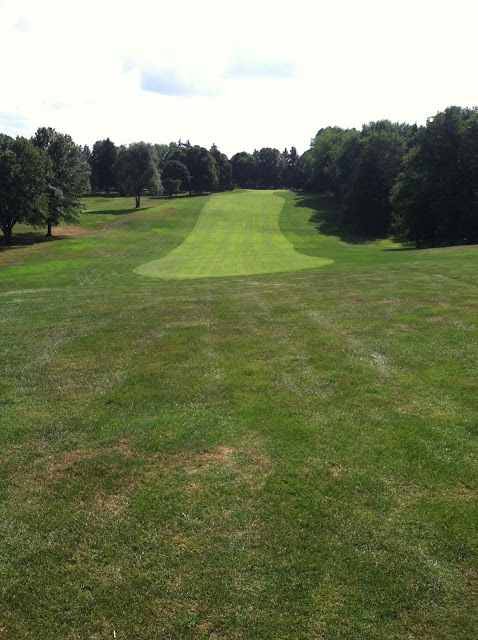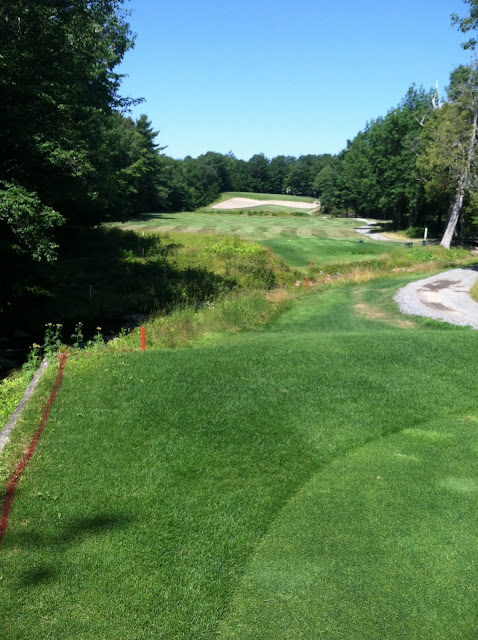The first hole is a 401 yard par four that doglegs right. It takes a big drive to get past the trees, something that the short hitter will have to overcome by keeping the ball down the left in order to have a straight shot into the hole.
What a great looking hole! The obvious hazard is the slope short of the green, but the player will realize after a few plays that being long is no picnic either. Bunkers cut into the base of the slope not only add to the forbidding look, but play very difficult should ones ball find them.
The dogleg is a bit awkward mostly due to the trees that guard the corner. Too high in my opinion. This means laying up at the turn and hitting up to the green. Long hitters who can hit far enough maybe able to get an angle that takes tree out of play.
The 421 yard fourth might be the toughest par on the course. As fast as it drops from the tee is as fast as it rises to the green.
No bunkers needed! It plays into the wind and uphill. A four is a good score.
The fifth is an awesome short par four!!
It's 363 yards, the fairway rumples out, doglegging left and falling away on the right. The approach is where the blood gets pumping.
I love how the green sits atop the ridge. The putting surface has a valley straight down the middle with plateau wings on the side. I haven't seen a green this good in a long time!! It's the best Sandy Alves hole I've played!!
This 345 yarder has an extremely small green. The proper play is determining where to hit the tee ball. I was where the pic was taken, and the ball was above my feet which is difficult to judge the amount of sidespin. The three deep bunkers on the left see a lot of action because of that slope.
Seven is pretty vanilla, and plays straightaway. It's a lil downhill, and should offer a fine chance at getting a birdie. Eight follows with a nice par three. It looks like the green is closer than the yardage says, but it really does play it's listed yardage, possibly more.  It's a very nice par three, and has some great views. It's not a difficult hole, but it's work to put a deuce on the card.
It's a very nice par three, and has some great views. It's not a difficult hole, but it's work to put a deuce on the card.
 It's a very nice par three, and has some great views. It's not a difficult hole, but it's work to put a deuce on the card.
It's a very nice par three, and has some great views. It's not a difficult hole, but it's work to put a deuce on the card. The ninth is a fine ending hole. It's a 454 yard par four that plays across the water to a fairway draped across the hill.  The first inclination is to cut the corner of the dogleg left, but a good drive up the right center is the best choice.
The first inclination is to cut the corner of the dogleg left, but a good drive up the right center is the best choice.
 The first inclination is to cut the corner of the dogleg left, but a good drive up the right center is the best choice.
The first inclination is to cut the corner of the dogleg left, but a good drive up the right center is the best choice. Nine hole courses are possibly the future of golf. When I was in Maine, I came across a nine holer called The Causeway Club, and the started told me how he felt eighteen holes was overrated. I think time is very valuable, and nine holers do have a place in golf. (18 holes is not overrated)
((My opinion)) Twin Lakes is a really good nine hole course. It has scenery, good architecture, a variety of holes, and great greens. I'm pretty excited to play it again.
(5)
































